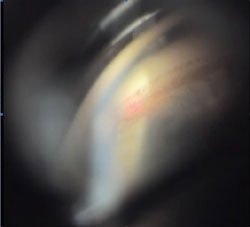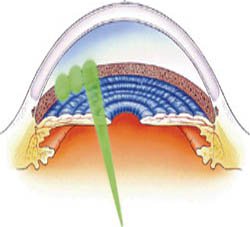SLT may lower IOP in glaucoma patients under drug therapy
Selective laser trabeculoplasty may be a viable option for patients who require a slight pressure reduction or those with drug intolerances.
 Cornelia Hirn |
 Jens Funk |
In a clinical study, we are investigating the effectiveness of selective laser trabeculoplasty in glaucoma patients in whom adequate IOP has not been achieved despite maximum tolerated topical therapy.
We are investigating whether additional IOP reduction occurs when SLT is applied and if so, how long it is maintained. Because our follow-up covers a postoperative period of 1 year, we are also examining the option and effectiveness of possible re-treatment.
Patients with primary open-angle glaucoma (including normal-tension glaucoma), pseudoexfoliation glaucoma and ocular hypertension are enrolled in our open, prospective, non-controlled study. The standard exclusion criteria apply. A previous argon laser trabeculoplasty is not considered an exclusion criterion. Follow-up examinations are performed after 2 hours and 1, 30, 90, 180 and 360 days postoperative.
Currently, the recruitment phase has been completed, and 6-month postoperative results are available.
Technical prerequisites and mechanism of action
Because of the different parameters in SLT, a separate laser with specific settings is necessary for this procedure. The required short impulse duration is not attained with the usual retinal laser, although it is identical in appearance.
The SLT is performed with a frequency-doubled, Q-switched Nd:YAG laser, which functions with a wavelength of 532 nm. The laser beam diameter is 400 µm; the pulse duration is 3 nanoseconds.
Unlike ALT, SLT is a non-thermal laser treatment. Its mechanism of action is probably based on the stimulation of endothelial cells. The energy flow density, which is smaller by a factor 1,000, explains the lower thermic effect. In SLT, there is selective absorption of the laser energy by the pigment cells of the trabecular meshwork. The SLT treatment can be repeated without any great risk or damage.
SLT procedure
All study participants received brimonidine eye drops immediately preoperative. Then a contact glass was positioned; we use the Latina SLT lens.
During the clinical study, we performed a circular 360· treatment with 100 continuous, non-overlapping laser spots as standard. The focus during treatment must lie on the pigment cells to be treated and not on the laser spots.
The energy is adapted to the degree of pigmentation of the trabecular network (energy between 0.3 mJ and 1.6 mJ). The corresponding selected initial energy is increased stepwise by 0.1 mJ until champagne bubbles form. Then the energy level is decreased in steps of 0.1 mJ below this threshold.
Patient information
Thirty patients were enrolled in the study (20 women, 10 men). Fifteen right eyes and 15 left eyes were treated with an SLT. Our patient collective consisted of 20 patients with primary open-angle glaucoma (four of these with normal-tension glaucoma), seven patients with pseudoexfoliation, two with ocular hypertension and one patient with juvenile glaucoma.
We place great value on good, thorough and open patient information before the SLT procedure. We emphasize that laser treatment is completely harmless and painless. We explain that the patient may be blinded after the SLT due to the illumination during the procedure and not be able to see for up to 30 minutes after the procedure. We also caution that positioning of the contact glass may cause mild mechanical irritation (a scratchy feeling in the eye), and that the eye may become somewhat reddened after the procedure.
|
|
|
|
Figures 1-2. The laser energy is adapted to
the degree of pigmentation of the trabecular network (energy between 0.3mJ and
1.6 mJ). The corresponding selected initial energy is increased stepwise by 0.1
mJ until champagne bubbles form.
Image 1: Melamed S. Image 2: Ellex
Medical Lasers |
|
After performing the SLT, we point out to our patients that they must continue to take their glaucoma medication for the time being. The original topical glaucoma therapy is continued, especially since the SLT effect may be delayed and must first be checked. After about 6 months, we determine if the medication can be discontinued.
In our study thus far, this applies to three patients who no longer require medication 6 months after the procedure. In one further patient, we were able to reduce therapy with eye drops.
Postoperative drug therapy
We continue the preoperative drug glaucoma therapy unchanged during the initial postoperative period.
All SLT procedures performed during the study were without complications. The treatment time itself was very short and lasted for less than 10 minutes.
Despite preoperative administration of brimonidine, we observed a paradox IOP increase (IOP more than 26 mm Hg) in three patients (10%) 2 hours after the procedure. These patients were treated additionally with 250 mg of acetazolamide.
Eleven patients developed mild inflammatory reactions in the anterior chamber after the SLT. These healed spontaneously; we did not administer any additional anti-inflammatory drops. There was no formation of synechia in the anterior chamber angle in any of the patients.
Results
In our patient collective, we were able to reduce the mean IOP from 19.6 ± 4.69 mm Hg preoperative to 15 ± 3.21 mm Hg (–23.3%, P < .001) after 1 month, 15.7 ± 3.3 mm Hg (–20%, P = .002) after 3 months and 16.3 ± 2.91 mm Hg (–16.7%, P = .012) after 6 months. Expressed in absolute figures, we used the laser successfully for the classical indication, ie, in patients who need additional IOP reduction of about 4 mm Hg to achieve target pressure.
Examination of postoperative visual acuity revealed unchanged values after 1, 3 and 6 months. No serious complications occurred postoperatively.
Conclusions
SLT is a non-thermic laser treatment that, unlike ALT, does not cause coagulative cell damage. It enables an IOP reduction of 20% to 25%, even in patients under maximum therapy, without causing serious side effects or complications. Further laser treatments and subsequent filtering procedures are possible. SLT is a good option in existing compliance problems. Its use could enable lower treatment costs because less topical therapy is required or local therapy might even be totally unnecessary.
Future indications for SLT are patients in whom only a slight additional pressure reduction is needed to achieve the target pressure and/or patients with drug intolerances.
References:
- Damji KF, Shah KC, Rock WJ, Bains HS, Hodge WG. Selective laser trabeculoplasty v argon laser trabeculoplasty: a prospective randomised clinical trial. Br J Ophthalmol. 1999;83(6):718-722.
- Latina MA, Park C. Selective targeting of trabecular meshwork cells: in vitro studies of pulsed and CW laser interactions. Exp Eye Res. 1995;60(4):359-372.
- Stein JD, Challa P. Mechanisms of action and efficacy of argon laser trabeculoplasty and selective laser trabeculoplasty. Curr Opin Ophthalmol. 2007;18(2):140-145.
- Cornelia Hirn, MD, can be reached at UniversitätsSpital Zürich/Eye Clinic, Glaucoma Research Group, Frauenklinikstr. 24, CH-8091 Zürich, Switzerland; 4144-255-4913/044-255-4900; fax: 4144-255-4472; e-mail: cornelia.hirn@usz.ch. Dr. Hirn has no direct financial interest in the products discussed in this article, nor is she a paid consultant for any companies mentioned.
- Jens Funk, MD, PhD, can be reached at UniversitätsSpital Zürich/Eye Clinic, Glaucoma Research Group, Frauenklinikstr. 24, CH-8091 Zürich, Switzerland; 4144-255-4913/044-255-4900; fax: 4144-255-4472; e-mail: jens.funk@usz.ch. Dr. Funk has no direct financial interest in the products discussed in this article, nor is he a paid consultant for any companies mentioned.



